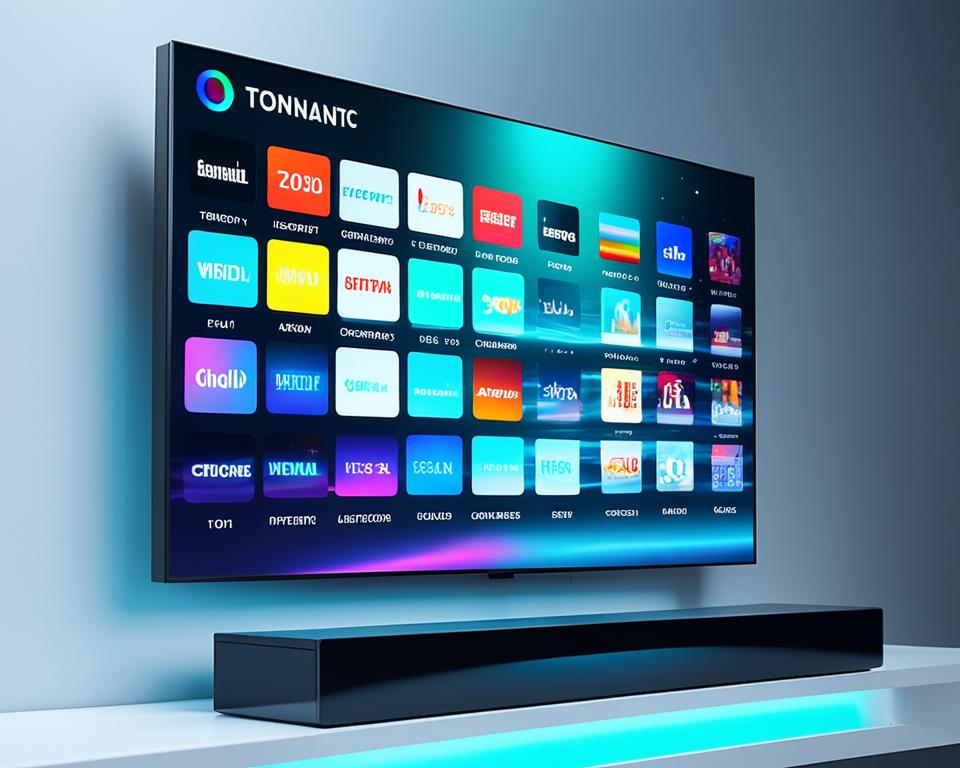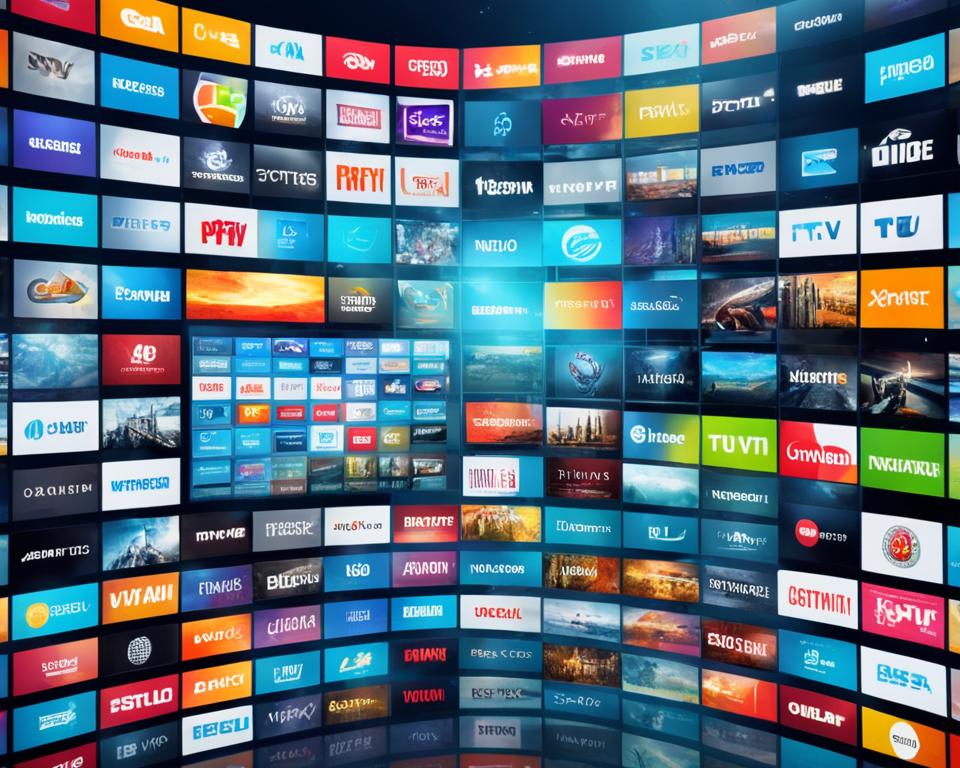Are you tired of being restricted by the limited channel options of traditional TV? Do you wish you could have more control over what you watch and when you watch it? The answer lies in IPTV – Internet Protocol Television. But how does IPTV work, and how does it revolutionize the way we consume television content?
Unlike traditional TV services that rely on cable or satellite signals, IPTV leverages internet protocol technology to stream channels directly to your devices. This means that you can access a vast array of streaming TV services with just an internet connection, giving you the freedom to choose what and when you want to watch.
Key Takeaways:
- IPTV utilizes internet protocol technology to stream television content.
- It provides a wide range of streaming TV services, offering more channels and customization options.
- IPTV works by capturing, encoding, and transmitting content over IP networks.
- Setting up IPTV involves connecting to an IPTV service and using compatible streaming devices.
- IPTV offers numerous advantages over traditional TV, such as on-demand content and improved video quality.
What is IPTV?
In today’s digital age, traditional television has evolved with technological advancements, giving rise to a new way of consuming content – Internet Protocol Television (IPTV). IPTV is a cutting-edge technology that utilizes internet protocol to deliver television channels and on-demand content directly to the viewer’s device. It differs significantly from traditional television, offering a more flexible and advanced viewing experience.
IPTV leverages internet protocol technology to transmit television signals over IP networks, such as the internet. Instead of relying on satellite or terrestrial signals, IPTV streams content through data packets, delivering it in real-time or on-demand to users around the world. This revolutionary approach allows viewers to access a vast range of channels and content options, transcending geographic limitations and offering unparalleled convenience.
The use of internet protocol technology in IPTV brings several advantages. It enables the seamless integration of television, internet, and interactive services, allowing viewers to surf the web, access online apps, and communicate while watching their favorite shows. Moreover, IPTV technology ensures superior video and audio quality, delivering crystal-clear images and immersive sound.
“Internet Protocol Television enables viewers to access a vast range of channels and content options, transcending geographic limitations and offering unparalleled convenience.”
IPTV encompasses both live TV broadcasting and on-demand content. It enables viewers to watch shows and movies at their convenience, with the ability to pause, rewind, or fast-forward, essentially giving users full control over their viewing experience. This flexibility is particularly appealing to busy individuals who can catch up on their favorite shows whenever and wherever they want.
Whether it’s catching up on the latest episode of a favorite series, watching live sporting events, or exploring a vast library of movies, IPTV offers an extensive range of channels and content options to cater to every viewer’s preferences. With IPTV, viewers can customize their channel lineup, selecting the genres and programs that interest them the most.
| Advantages of IPTV | Limitations of IPTV |
|---|---|
|
|
Despite its limitations, the possibilities and advantages offered by IPTV make it an exciting and rapidly growing technology in the world of television. It has the potential to transform the way we consume content, offering viewers a more personalized and interactive viewing experience.
How Does IPTV Work?
Understanding the technical workings of IPTV is essential to fully grasp its capabilities and potential. In this section, we will delve into the intricate processes involved in capturing, encoding, and transmitting content over IP networks. Additionally, we will explore the crucial role played by IPTV providers in delivering high-quality television programming directly to viewers’ screens.
- Capturing Content: Before content can be streamed over IPTV, it needs to be captured from various sources, such as satellite signals, cable networks, or video cameras. This content is typically delivered to a central server that acts as the backbone of the IPTV system.
- Encoding: Once the content is captured, it undergoes an encoding process to compress it into a digital format suitable for transmission over IP networks. This compression helps optimize bandwidth usage and ensures smooth streaming.
- Transmission: The encoded content is then transmitted over IP networks, which can include the internet or private networks, using internet protocol packets. These packets are sent from the central server to individual viewers’ devices, allowing them to access the desired channels and programs.
While the technical workings of IPTV are fascinating, it’s important to understand the crucial role played by IPTV providers in making this technology accessible to viewers. These providers are responsible for managing the infrastructure, server maintenance, content licensing, and ensuring seamless delivery of the IPTV service to subscribers’ devices.
Key Components in the IPTV Workflow
| Component | Description |
|---|---|
| Content Sources | Satellite signals, cable networks, video cameras |
| Central Server | Stores and distributes content to viewers |
| Encoding | Compression of content into digital format |
| IP Networks | Transmission of encoded content |
| IPTV Providers | Manage infrastructure and ensure seamless delivery |
In summary, IPTV works by capturing, encoding, and transmitting content over IP networks, allowing viewers to access a wide range of television programming. IPTV providers play a pivotal role in making this technology accessible and ensuring a smooth viewing experience for subscribers.

Setting Up IPTV
Setting up IPTV at home is a simple process that requires the right hardware and a reliable internet connection. By following these step-by-step instructions, you can easily enjoy the benefits of IPTV streaming on your preferred devices.
1. Choose the Right IPTV Streaming Device
Start by selecting a compatible IPTV streaming device that suits your preferences and budget. Popular options include:
- Amazon Fire TV Stick
- Roku Streaming Stick
- NVIDIA Shield TV
- Apple TV
These devices allow you to connect to your IPTV service and enjoy seamless streaming on your television.
2. Connect the IPTV Streaming Device
Once you have your IPTV streaming device, follow these steps to connect it to your television:
- Connect the device to an available HDMI port on your TV.
- Plug the device into a power outlet using the provided power adapter.
- Turn on your TV and select the appropriate HDMI input where the device is connected.
3. Set Up Your Internet Connection
In order to stream IPTV content, you need a stable internet connection. Make sure you have a high-speed internet service with a reliable provider. Connect your IPTV streaming device to your home Wi-Fi network by following these steps:
- Go to the device’s settings menu.
- Select “Network” or “Wi-Fi” settings.
- Choose your Wi-Fi network from the available list.
- Enter your Wi-Fi password and connect to the network.
4. Download and Install IPTV App
Next, you need to download and install the IPTV app on your streaming device. The specific app may vary depending on your IPTV service provider. To install the app, follow these steps:
- Access the app store on your streaming device (e.g., Amazon Appstore, Google Play Store).
- Search for the IPTV app by entering the name in the search bar.
- Select the app from the search results.
- Click on the “Install” or “Download” button to begin the installation process.
Once the app is installed, launch it on your streaming device and follow any on-screen instructions to log in to your IPTV service account.
With your IPTV streaming device connected to your television and the app installed, you’re now ready to enjoy a wide range of channels and content right at your fingertips.
In the next section, we’ll explore the variety of channels available through IPTV and the subscription options offered by IPTV providers.
IPTV Channels and Subscription
When it comes to IPTV, one of the biggest advantages is the vast selection of channels available. Gone are the days of flipping through countless cable channels and only finding a handful that pique your interest. With IPTV, you have access to a wide range of channels catering to various interests, genres, languages, and regions.
Whether you’re a sports enthusiast, a movie buff, or a fan of international programming, IPTV has something for everyone. From popular mainstream channels to niche networks and specialty content, the choices are virtually endless. You can tune in to live sports events, catch up on your favorite TV shows, or explore new and exciting programs from around the world.
Customization and Flexibility
Another key feature of IPTV is the flexibility it offers in terms of channel selection. Unlike traditional cable or satellite TV packages that come with predetermined channel lineups, IPTV allows you to personalize your viewing experience. With IPTV subscriptions, you can often choose from different packages or tiers, each offering a specific selection of channels.
These packages are designed to cater to different preferences and budgets, ensuring that you only pay for the channels you truly want to watch. This level of customization allows you to create a channel lineup that aligns with your interests and preferences, giving you full control over your entertainment choices.
Furthermore, IPTV providers often offer additional options for channel add-ons or premium networks, allowing you to expand your channel lineup even further. This means you can access exclusive content from popular networks or enjoy specialty channels that cater to specific interests.
“IPTV provides a level of channel customization that traditional TV services simply can’t match. With the ability to choose from various packages and add-ons, viewers can curate their own personalized channel lineup.”
Choosing an IPTV Subscription
When it comes to selecting an IPTV subscription, it’s important to choose a reputable provider that offers reliable service and a wide range of channels. There are numerous IPTV providers in the market, each offering different subscription plans and channel options.
Before committing to a subscription, it’s wise to research and compare different providers to find the one that best suits your needs. Look for providers with a solid reputation, positive customer reviews, and a track record of delivering high-quality IPTV service.
Consider factors such as channel selection, pricing, customer support, and additional features like DVR or on-demand content. Take advantage of free trials or demos wherever possible to assess the quality of the service and the available channel lineup.
By choosing the right IPTV subscription, you can unlock a world of entertainment at your fingertips, ensuring that you have access to the channels you love most.

| Provider | Channel Selection | Pricing | Customer Reviews |
|---|---|---|---|
| StreamUtopia | 80000+ | $14.99/month | 4.8/5 |
Advantages of IPTV
IPTV offers numerous advantages over traditional TV services, providing an enhanced viewing experience for users. Let’s explore some of the key benefits:
- On-Demand Content: With IPTV, users have access to an extensive library of on-demand content. This means you can watch your favorite shows, movies, and documentaries whenever you want, without being constrained by a fixed schedule. Whether it’s catching up on missed episodes or exploring new releases, IPTV offers unparalleled convenience.
- Time-Shifting Capabilities: IPTV allows users to pause, rewind, and fast-forward live TV. This feature gives you control over your viewing experience. Missed an important scene? Simply go back and watch it again. Need to take a quick break? Pause the show and resume when ready. IPTV empowers viewers with the freedom to watch TV on their terms.
- Improved Video Quality: Internet Protocol Television delivers high-definition content, offering superior video quality compared to traditional TV services. With advanced compression technologies, IPTV ensures crisp and clear visuals, immersing viewers in a captivating entertainment experience. Say goodbye to pixelated screens and embrace the stunning clarity of IPTV.
These advantages cement IPTV’s position as a leading option for streaming TV services. As the technology continues to evolve, users can expect even more innovative features and improvements in the future.
| Advantages of IPTV | Description |
|---|---|
| On-Demand Content | Access to a vast library of on-demand shows, movies, and documentaries |
| Time-Shifting Capabilities | Pause, rewind, and fast-forward live TV for complete control over your viewing experience |
| Improved Video Quality | High-definition content with superior video quality for a more immersive and enjoyable viewing experience |
Challenges and Limitations of IPTV
While IPTV offers numerous benefits and has revolutionized the way we consume television content, it does come with its fair share of challenges and limitations. It is important for users to have a realistic understanding of these drawbacks to make informed decisions about their streaming TV services.
1. Potential Network Congestion
One of the key challenges of IPTV is the possibility of network congestion. As IPTV relies on internet connectivity to deliver content, a high volume of users streaming simultaneously can lead to network congestion and affect the quality of the streaming experience. This can result in buffering issues and interruptions during live broadcasts or on-demand content playback.
2. Buffering Issues
Buffering is another limitation that IPTV users may encounter. Buffering refers to the delay that occurs when streaming content needs to load in advance to ensure smooth playback. Factors such as internet speed, device performance, and network stability can impact buffering. While advancements in technology have significantly reduced buffering, it may still occur, especially in areas with limited internet infrastructure.
3. Dependence on Reliable Internet Connectivity
IPTV relies heavily on a reliable and stable internet connection. In areas with poor or limited internet infrastructure, users may face difficulties in accessing IPTV services. Unreliable or slow internet speed can lead to pixelated video quality or constant buffering, resulting in a frustrating viewing experience.
4. Availability of IPTV Providers
The availability of IPTV providers can be a limitation for some users. While IPTV has gained popularity, not all regions or countries have a wide range of providers to choose from. This limited choice may impact the availability of desired channels or specific content tailored to individual preferences.
Despite these challenges and limitations, IPTV technology continues to evolve and improve, with efforts made to enhance network infrastructure and reduce buffering issues. It is important to research and choose reputable IPTV providers that offer reliable services and prioritize customer satisfaction.

As the IPTV industry continues to grow, providers are actively working towards overcoming these challenges, ensuring a seamless and immersive streaming experience for users. By staying informed and understanding the limitations, users can make the most of the IPTV technology and enjoy their favorite shows and movies on demand.
Future of IPTV
The future of IPTV looks promising, with advancements in technology and emerging trends shaping the way we consume TV content. As streaming TV services continue to gain popularity, the demand for IPTV is expected to grow.
One of the key areas of development is the improvement of streaming quality. As internet speeds increase and bandwidth becomes more abundant, IPTV providers can deliver high-definition and even 4K content seamlessly. Viewers can expect an enhanced viewing experience with sharper images and smoother playback.
Another exciting aspect is the integration of artificial intelligence (AI) and machine learning into IPTV technology. AI algorithms can analyze user preferences and behavior, providing personalized recommendations for content. This level of customization ensures that viewers have access to the shows and movies they are most interested in, saving time and enhancing user satisfaction.
Additionally, the rise of smart homes and IoT devices presents new opportunities for IPTV. With the integration of IPTV services into smart TVs, smartphones, and other smart devices, users can enjoy their favorite shows and channels from any location in their homes. The ability to control IPTV services through voice commands and smart home automation further simplifies the TV viewing experience.
Furthermore, the future of IPTV includes the potential for interactive features and social integration. IPTV providers can introduce interactive elements, such as live polls, real-time chats, and interactive advertisements, to engage viewers and create a more immersive TV experience. Social media integration can enable users to share their favorite shows and moments with their social networks, fostering a sense of community and enhancing the social aspect of TV viewing.
“The future of IPTV lies in seamless streaming, personalized recommendations, and interactive features that enhance the viewer’s experience.”
In conclusion, IPTV technology is continuously evolving, and its future is bright. With advancements in streaming quality, AI integration, smart home compatibility, and interactive features, IPTV is set to redefine the way we consume TV content. As streaming TV services become more prevalent, it is clear that IPTV will play a significant role in the future of entertainment.
Conclusion
Internet Protocol Television (IPTV) has revolutionized the way we consume television content. By leveraging internet protocol technology, IPTV offers a new way to stream TV services directly to our screens. Throughout this article, we have explored how IPTV works and its potential in the ever-evolving TV industry.
Through IPTV, viewers can enjoy a wide range of channels and customize their subscription to suit their preferences. This technology offers on-demand content, allowing users to watch their favorite shows and movies whenever they want. With the ability to time-shift, viewers can pause, rewind, or fast-forward through programs, adding convenience to their TV viewing experience.
While IPTV has many advantages, it also comes with its challenges. Network congestion and buffering issues can sometimes hinder smooth streaming. Additionally, reliable internet connectivity is essential for uninterrupted IPTV service. However, as technology progresses, these limitations are being addressed, and the future of IPTV looks promising.
As the TV industry continues to evolve, IPTV is poised to play a significant role. With advancements in IPTV technology, we can expect improved video quality, enhanced features, and increased accessibility. As more consumers embrace streaming TV services, IPTV will shape the way we consume content, offering greater flexibility and convenience.
FAQ
What is IPTV?
How does IPTV work?
How do I set up IPTV at home?
What channels are available through IPTV?
How do I subscribe to IPTV?
What are the advantages of IPTV?
What are the challenges and limitations of IPTV?
What is the future of IPTV?






